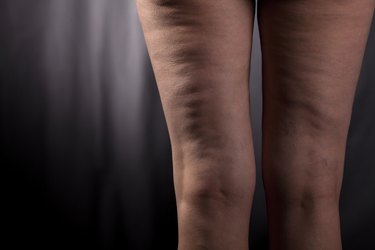
If you have cellulite, stretch marks or both, you are not alone. A whopping 90 percent of women have cellulite and 80 percent of Americans have stretch marks. They are both harmless, but that probably doesn't make their appearance bother you any less. No matter what the cause, you may be able to reduce the appearance of cellulite and stretch marks once and for all. All it takes is a little commitment and dedication.
The Dreaded Dimples
Video of the Day
Cellulite manifests as dimpled skin, especially on the thighs, buttocks, hips and abdomen. Women experience cellulite more often than men, but both sexes may be plagued with the problem. Stretch marks, medically referred to as striae, are indented streaks on the skin that most often appear on the abdomen, breast, upper arms, buttocks and thigh. Stretch marks usually start out pink, red or purple and then fade to white and development a scar-like appearance as time goes on.
Video of the Day
The Science Behind Your Woes
Your skin is attached to your muscles with cords of connective tissue. Between your skin and your muscle lies a layer of fat. Cellulite develops when fat cells accumulate underneath the skin and push against the skin while the connective cords pull down. This causes a bulging that creates the characteristic dimpling of cellulite. As the name implies, stretch marks develop as a result of rapid stretching of the skin.
Reasons for the Trouble
Genetics are the biggest factor in determining whether or not you develop cellulite, although other factors play a role. Weight gain can make cellulite more noticeable, although slender individuals may have cellulite too. Other factors that contribute to cellulite include a sedentary lifestyle, stress and the use of birth control pills. Stretch marks usually occur as a result of substantial weight gain or loss, not genetics. Pregnancy is a common cause of stretch marks, as is obesity. In some cases, stretch marks may be the result of medications or adrenal gland diseases.
Smoothing Things Out
While it's possible to reduce the appearance of both cellulite and stretch marks, you may not be able to get rid of the conditions completely. Weight loss can help reduce the appearance of cellulite, although lasers and radiofrequency treatments are the most promising medical options. Retinol in cellulite creams is thought to resurface and thicken the skin, diminishing the dimpled appearance, while ingredients like caffeine and aminophylline are believed to promote the breakdown of fat. As with cellulite, laser therapy and topical retinol creams are an option for stretch mark treatment. Paula's Choice notes that tretinoin, the active ingredient in prescription retinoids, can diminish the appearance of stretch marks by up to 20 percent. Another option is a TCA, peel, which penetrates deeply into the skin to stimulate collagen and elastin. To be effective, TCA peels must be used atabout a 20-percent concentration and must be applied by a medical professional with proper knowledge of the product.
- Medline Plus: Cellulite
- Medical News Today: What is Cellulite? What Causes Cellulite?
- CNN Health: Cellulite
- ABC News: 15 Myths and Facts About Cellulite
- Medline Plus: Striae
- CBS News: Stretch Marks Getting Under Your Skin?
- Paula's Choice: Stretch Marks -- What Works (And What Doesn't)
- The University of New Mexico: Cellulite -- A Review of its Anatomy, Physiology and Treatment
Is this an emergency? If you are experiencing serious medical symptoms, please see the National Library of Medicine’s list of signs you need emergency medical attention or call 911.